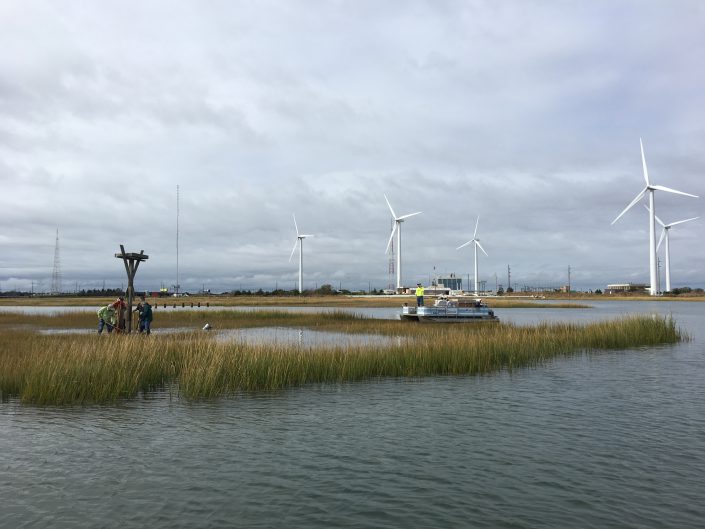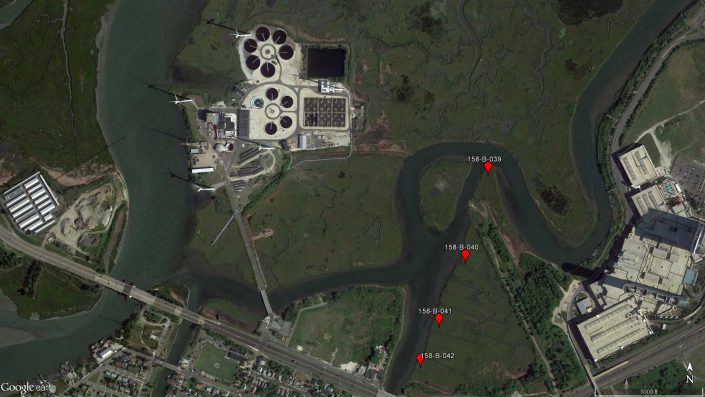Giving Absecon’s ospreys a boost
Volunteers brave rain and high water to benefit ospreys!
by Ben Wurst, Habitat Program Manager

I’ve been surveying osprey colony on Absecon Bay since 2008, after I moved to the local area. It’s been an area with a small but slowly growing colony. In 2008 there were a total of 11 active nests. This year there were 23 active nests. Productivity has been good with an average of 1.72 young/active (known-outcome) nest over the past nine years (more than double what’s needed to sustain the population). Many of the nests in this area were installed in 2005 for mitigation for nests that were removed when the ACUA installed large wind turbines off Route 30. But, some platforms that were placed near the turbines, have been slowly abandoned by ospreys. This year only one nest was occupied there and it did not produce any young.

While I am not 100% sure why the nests placed near ACUA have never been used or abandoned, I can only guess that the turbines play a role in their nest site selection. 158-B-039 was last active in 2010. 158-B-040 and 042 have never been occupied. We left 158-B-041, since it was last active in 2015. It’s interesting how these platforms sit empty as ospreys have chosen to nest atop large billboards to the south (on the AC Expressway). To help put these structures to good use, we decided to move them to replace older and smaller platforms that are prone to fail from the young falling from their nests.
This work occurred on Friday, October 21, where we have over ten volunteers respond to our call for help. We ended up having a little too many helpers as we were limited by the number of people that our boats (we need a bigger boat!!) could hold. We had a total of three boats, one of which was operated by Ron Meischker with Assualt on Patcong Creek, a charity crabbing event in Somers Point. With Ron’s help transporting our team of strong volunteers, we moved from platform to platform to remove and install them. We started by removing the first platform together as a group then left on our “fast” boat to bring that platform to its new home while the pontoon boat was removing the second platform, etc.. While we were working on relocating those platforms, another team of two, Mike and Jim, went around and repaired many other platforms.
All in all we really lucked out with a great, productive day in the field. I was a bit worried in the early morning with some light rain that was falling, but that ended when the sun came out at around 1pm. The water was high due to the astronomical high tide from the full moon earlier in the week, the onshore flow of wind, and a low pressure system that was right overhead. So, for most of us, our feet got a little wet, but with the water still being slightly warm it didn’t really affect our ability to work hard to accomplish our mission. Note to self – wear hip boots next time!
Thank you to everyone who volunteered to help make this project a success: Jerry, Davina, Jim, Tim, Ron, Jack, Steve, Gene, Raymond, and Mike!
Discover more from Conserve Wildlife Foundation of NJ
Subscribe to get the latest posts sent to your email.
Leave a Comment
great job! If you guys don’t slow down, this osprey colony will surpass the one in the Sedge Islands Marine Conservation Zone as the largest in New Jersey.
I don’t think you have to be a genius to figure out why the Osprey were not occupying those nests. Darn it. God bless you folks for all the work you’ve done. I look forward to next spring when our beautiful Osprey return and multiply.
Thank you for the praise, Linda. In defense of those who chose these locations, these are the first turbines that were installed in NJ and no one really knew how they would affect the nesting ospreys in the area. There are also many other things that could have caused the birds to abandon some of these nest sites, like human disturbance, predation, etc..
Comments are closed.